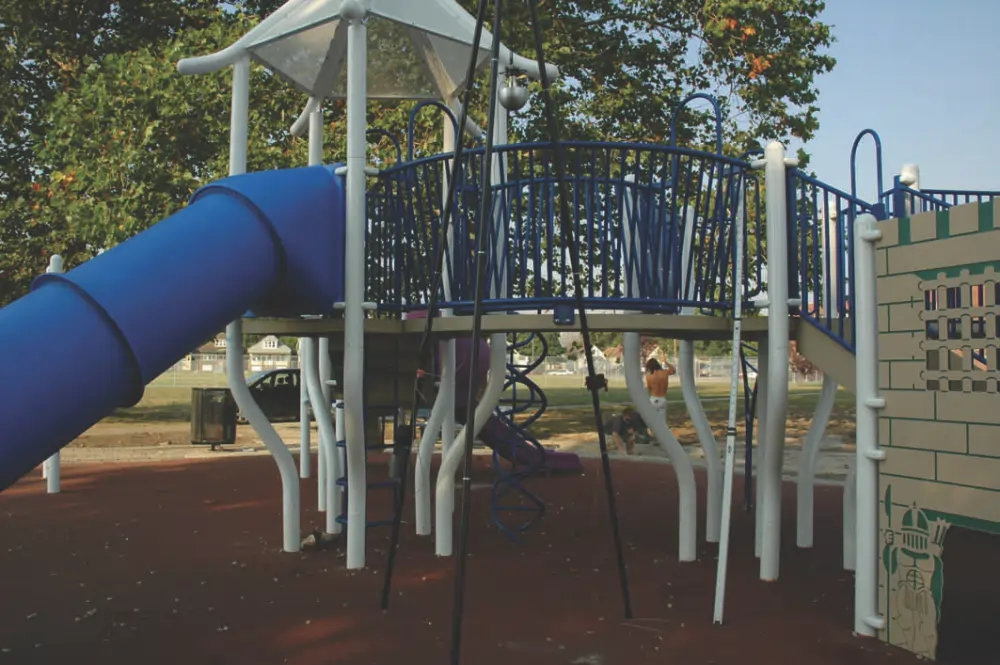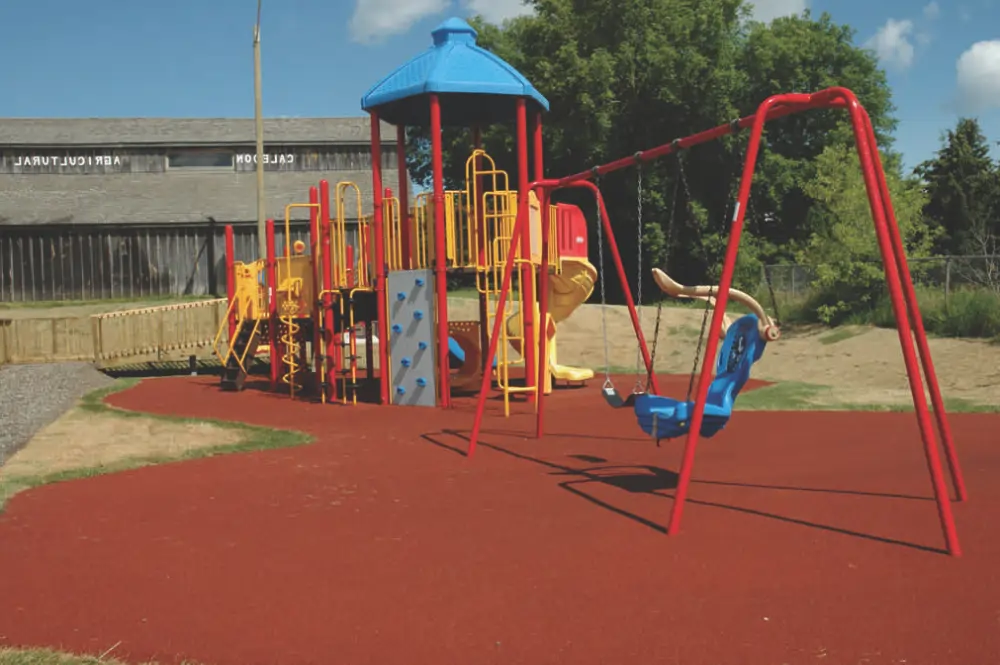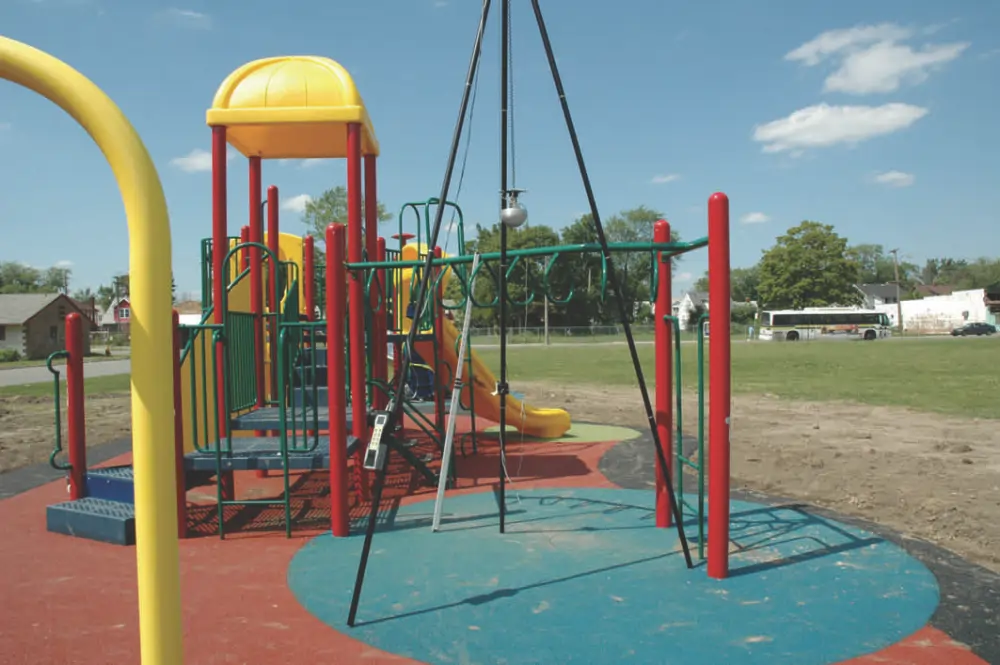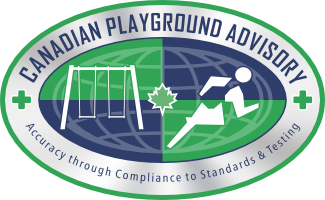Impact Attenuation and Injury Reduction
EVERPLAY International Inc.: Volume 14, Issue 2, February 2007
The playground must provide challenging play opportunities balanced with the protection of the child from the life-threatening or debilitating injury. Children understand some of the injury risks they are subject to, but not the potential severity and therefore it is the responsibility of the stakeholders to create standards, practices, products and procedures to reduce the severity of any injury that could occur.
The US CPSC has determined that 79% of injuries in public playgrounds and 81% of the injuries on home equipment were the result of falls primarily to the surface below the equipment. Fractures are the most common injury (39%), with almost 80% of these involving the wrist, lower arm and elbow. Approximately 15% of the injuries were to the head and face resulting in concussion, internal injuries and fractures. Head injuries account for 5% of the total of all injuries related to falls to the surface.
The impact attenuating properties of the playground surface and how these values are measured will be the first line of defence for the child on the playground. This article will look at the issues involved in the determining of impact attenuation, the height from which a child can’t, could and will fall and what performance is allowed by various standards. Ultimately the expectation is that the minimum protection will be that required by playground standards. As a result there will a discussion of best practices that will provide increased protection for the child.
Methods of Measuring Impact Attenuation and the Implication

For many years there have been two accepted measures for determining
the impact attenuating properties of playground surfaces, Gmax and HIC
(Head Injury Criteria). Gmax is the maximum deceleration of a missile during an impact, expressed in g’s, while HIC
is a specific integral of
the acceleration-time history of an impact used to determine relative risk of a head injury. It has been determined that a Gmax value
greater than 200 or an HIC value greater 1000 could result in a life-threatening head injury. In most cases Standards for impact attenuation have taken these values as the maximum performance for
a surface to be used in an impact attenuation situation.

while HIC is a specific integral of
the acceleration-time history of an impact used to determine relative risk of a head injury. It has been determined that a Gmax value
greater than 200 or an HIC value greater 1000 could result in a lifethreatening head injury. In most cases Standards for impact attenuation have taken these values as the maximum performance for
a surface to be used in an impact attenuation situation.
In relation to subjecting children to HIC values of 1000, it may be
important to look at the relative risk of a head injury at different
values of HIC. At 1000 HIC there is a 99% risk of a minor head
injury (skull trauma without loss of consciousness: fracture of nose
and teeth; superficial face injures), a 90% risk of a moderate head
injury (Skull trauma with or without dislocated skull fracture and
brief loss of consciousness. Fracture of facial bones without dislocation; deep wound(s)) and 4% risk of a critical head injury
(cerebral contusion, loss of consciousness for more than 12 hours
with intracranial hemorrhaging and other neurological signs; recovery uncertain). Although the risk of minor and moderate injury is
still high, the virtual elimination of the critical head injury would
require an HIC not exceeding 800. By reducing the HIC to 500,
the risk of a minor head injury is 79%, and the risk of a moderate
injury is 38% . Having no injury at all at 500 HIC would be only
21%
Recent studies have focused on the long-bone injury in the playground and its
prevention. Most of these studies have related the risk of fracture to the
height of the standing surface of the playground above the protective surface.
Some have suggested that impact values of below 100 g’s would be appropriate, while other suggest 150 g’s. The only standard to consider this is the
ASTM F2223 “Standard Guide for ASTM Standards on Playground Surfacing”,
which states “that is should be recognized that serious injuries ( for example,
long bone injuries and so forth) might occur even though the playground
surface system meets the requirements of Specification F1292. Lower values
of g-max and HIC signify better performance for impact absorption.
Practical Implications to the Stakeholder
The reduction of injury will not only be associated with the impact absorbing
characteristics of the surface in relation to the various playground standards,
the height from which these properties are measured is critical to the prevention of injury. All playground standards, ASTM F1487, EN1176 and CSA
Z614 have generally measured from the location of the child’s feet, which is
considerably lower than the barrier or guardrail they will fall over to land on
the surface. It is anticipated that the CSA Z614 in the 2007 revision will be
adjusting this height to a measurement above the platform more in tune to
the top of barrier or guardrail. This is a major step forward in the protection
of children.
At this point we should understand that the surface should be impact absorbing, however consideration must be given to the need to provide firm and
stable surfacing for those among us that have a disability. This could be the
child or their caregiver. There are devices such as the rotational penetrometer that can be used to measure the firmness and stability of a surface. Beyond that the surface must comply to slope and change in level requirements.
Ultimately children by their nature will seek out their level of challenge and
this will involve a certain element of risk on their part. The playground stakeholders must facilitate the child having good play value at the playground and
returning home without the risk of a life-threatening or debilitating injury.
Best Practice
Prudence would dictate that from the point of view of the impact attenuating
surface, the best practice would be to have a surface that provides and Gmax
<150 and HIC <800 from the tops of barriers and guardrails. In addition any
warranty should be for not less than 5 years and provide the pass/fail for the
relevant standard is met from the same drop heights. Field testing and maintenance of the surface system are a key element for any surfacing system.

18 Automatic Rd.,
Unit 12,
Brampton, Ontario
L6S 5N5
Phone: 416-410-3056 Fax: 905-494-1136
Email: Rolf@everplay.com
Henry@everplay.com
Adam@everplay.com
Phone: 416-410-3056 Fax: 905-494-1136
Email: Rolf@everplay.com
Henry@everplay.com
Adam@everplay.com



